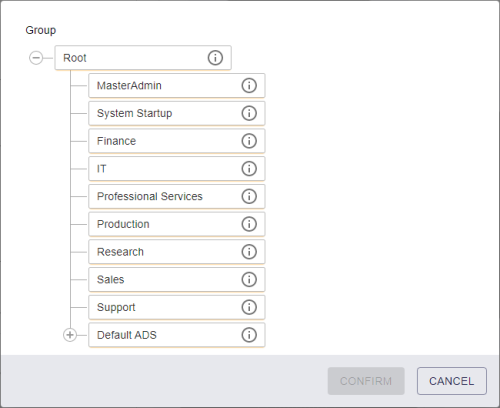5.1 Searching for a device
- Click the Devices category.
-
Select the search to use from the drop-down list.
By default, the following searches are available:
-
Devices – searches all devices.
-
Assigned Devices – searches only devices that are currently assigned to a person.
-
Unassigned Devices – searches only devices that are not currently assigned to a person.
However, your system may have additional custom device searches that you use for reporting.
-
-
Enter some or all of the search criteria for the target of the request.
If you are using the default Devices search, the following search criteria are available:
- Owner Name (contains) – type part of the device owner's name. You do not have to use wildcards; the search will match any part of the text you enter with the device owner's name.
-
 Group – select the group to which the person belongs.
Group – select the group to which the person belongs.
- Click the expand group icon
 to expand a group
to expand a group - Click the close group icon
 to close a group.
to close a group. - Click the group information icon
 to display information about the group.
to display information about the group. - Select a group, then click CONFIRM.
Note: If your system is configured for administrative groups, you can also select any of the groups for which you have administrative access, even if they are not within your own scope. Administrative groups are displayed at the bottom of the list in a separate node. For more information, see section 4.12, Working with administrative groups.
If you want to view devices for people from the groups below the selected group in the hierarchy, select the Include Subgroups option.
- Click the expand group icon
- Credential Profile – select the credential profile that was used to issue the device from the drop-down list.
- Device Type – select the type of device from the drop-down list.
- Process Status – select the status of the device from the drop-down list; for example, Active or Erased.
- Enabled – select whether or not the device is enabled from the drop-down list.
- Serial Number – type the serial number for the device. You can use wildcards.
You can also select the following Additional search criteria:
-
Chip – type the chip type for the device; for example, Oberthur ID-One PIV. You can use wildcards.
- Valid After – select the date after which the device became valid.
- Valid Before – select the date before which the device became valid.
- Expires After – select the date after which the device will expire.
- Expires Before – select the date before which the device will expire.
If you are using other searches, the criteria may be different.
-
For the Assigned Devices search, see section 7.3.4, Assigned Devices report.
-
For the Unassigned Devices search, see section 7.3.5, Unassigned Devices report.
-
Click SEARCH.
The list of matching results appears.
Search results are displayed in pages. Scroll to retrieve the next page of results automatically.
Note: The results are restricted to devices that have owners who fall within your scope, plus any unassigned devices.
-
Click a record to display the details of the device.
You can view information on the following tabs:
- DETAILS – view the basic details of the device, including device type, serial number, and owner.
- DEVICE CERTIFICATES – view the list of certificates stored on the device.
-
DEVICE REQUESTS – view any open requests for the device; for example, reprovision card tasks. You can click on the request in the list to view the full details of the request, and carry out actions such as approving, rejecting, or canceling the request.
For more information, see section 6, Working with requests.
From this screen, you can:
- Request a replacement device. See section 5.3, Requesting a replacement device.
- Renew a device. See section 5.4, Renewing a device.
- Cancel a device. See section 5.5, Canceling a device.
-
Reset the PIN for the device.
This feature launches the Reset Card PIN workflow in MyID Desktop. When the workflow completes, you are returned to the MyID Operator Client screen.
For information on using the Reset Card PIN workflow, see the Resetting a card's PIN section in the Operator's Guide.
-
Carry out an assisted activation.
This feature launches the Assisted Activation workflow in MyID Desktop. When the workflow completes, you are returned to the MyID Operator Client screen.
For information on using the Assisted Activation workflow, see the Assisted activation section in the Operator's Guide.
You can also view a device from any form that contains a link to the device.
For example:
- Click the item in the list on the DEVICES tab of the View Person form.
- Click the link icon
 on the Device Serial Number field of the View Request form.
on the Device Serial Number field of the View Request form.
5.1.1 Wildcards
For fields where you can use wildcards, you can use the following:
-
* for multiple characters.
For example, Sa* matches Sam, Samuel, and Samantha.
-
? for single characters.
For example, Sa? matches Sam, but not Samuel or Samantha.
Note: When searching for people, you cannot use ? for a single-character wildcard if you are searching an LDAP directory. The ? wildcard is supported only when searching in the MyID database.
